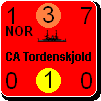Randomizer
Posts: 1473
Joined: 6/28/2008
Status: offline

|
Larry Reese wrote:
quote:
Lets say I have a division of 5 brigades. Is it useful (if you have them) to have one 2-star (div c.o.) and four 1-star for each brigade? A total of 5 generals in the division? I this useful in quick combat, or not?
This is the end state of command and control that I aim for but I cannot advise on the effects in QC since I never use it. However, the 1-Star's commanding the brigades can now rally them so one would think that your division would have better staying power and combat effectiveness.
Larry Reese wrote:
quote:
Also, are unified armies getting rooked? Let's say I have 150,000 men in an army, and opponent has 75,000 each in two armies in adjacent provinces...
Once again I cannot address quick combat but have had a great deal of success managing smaller armies operating in adjacent provinces for mutual support. Before declaring the system that appears to penalize huge armies as bogus, please consider a couple of small details. Once armies grew to over 100,000 men they tended to become cumbersome as they outstripped the ability to command them effectively using the means available. As late as 1914 the size of the army corps, about 45,000 men, was largely predicated on the maximum number that could deploy from line of march on one major route in one day and this was after wireless became available at the divisional level. The huge mass of the Army of the Potomac actually proved a disadvantage time and again compared to the leaner and easier to control ANV for example. The popular view is that Union incompetance kept them from bringing their overwhelming force to bear but what if it was not that simple and the armies had just grown too big to command with mounted orderlies and semiphore signals? The telegraph had little potential for tactical communications and there were no other options available. My take is that this effect is modelled reasonably well in FoF.
GrouchyXe wrote:
quote:
For a division commander we loook 1 to leadership, 2 to tactic, 3 to command
For a corps Idem but with more concern to initiative
For an army commander mainly initiative and command
This would work in my opinion and in most cases a poor general is better than no general at all.
GrouchyXe wrote:
quote:
By the way Grant is less good than McClellan ...
Not at all. Straight from the Commanders.txt file:
___________L T I C Cav
Grant______8 7 8 8 0
McClellan___7 3 1 4 0
These number seem reasonable to me, McClellan's leadership was legendary after all as were his lack of tactical initiative and command issues relating to things like use of intelligence and dealing with subordinates.
Good luck, Gentlemen
|
 Printable Version
Printable Version















 New Messages
New Messages No New Messages
No New Messages Hot Topic w/ New Messages
Hot Topic w/ New Messages Hot Topic w/o New Messages
Hot Topic w/o New Messages Locked w/ New Messages
Locked w/ New Messages Locked w/o New Messages
Locked w/o New Messages Post New Thread
Post New Thread